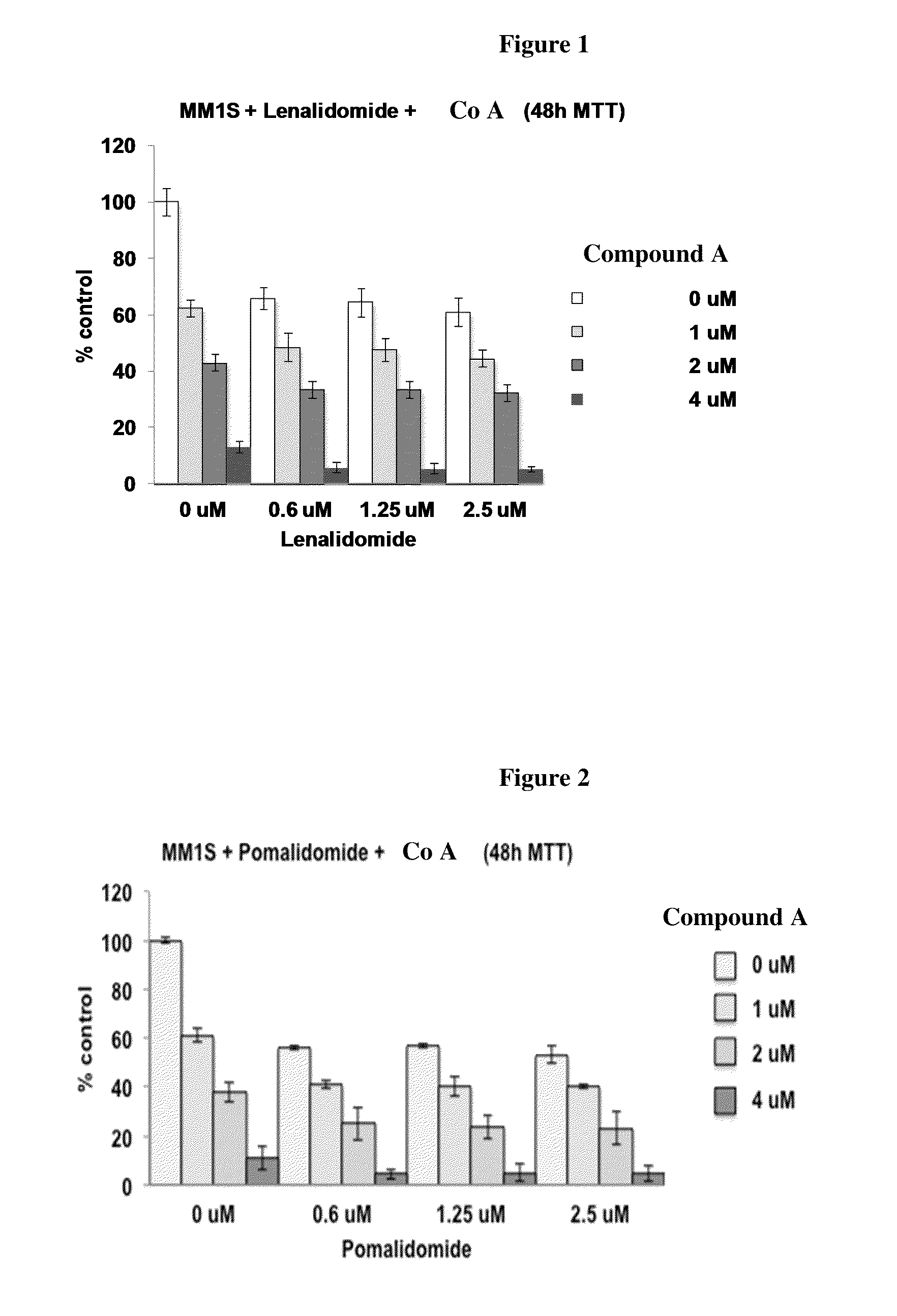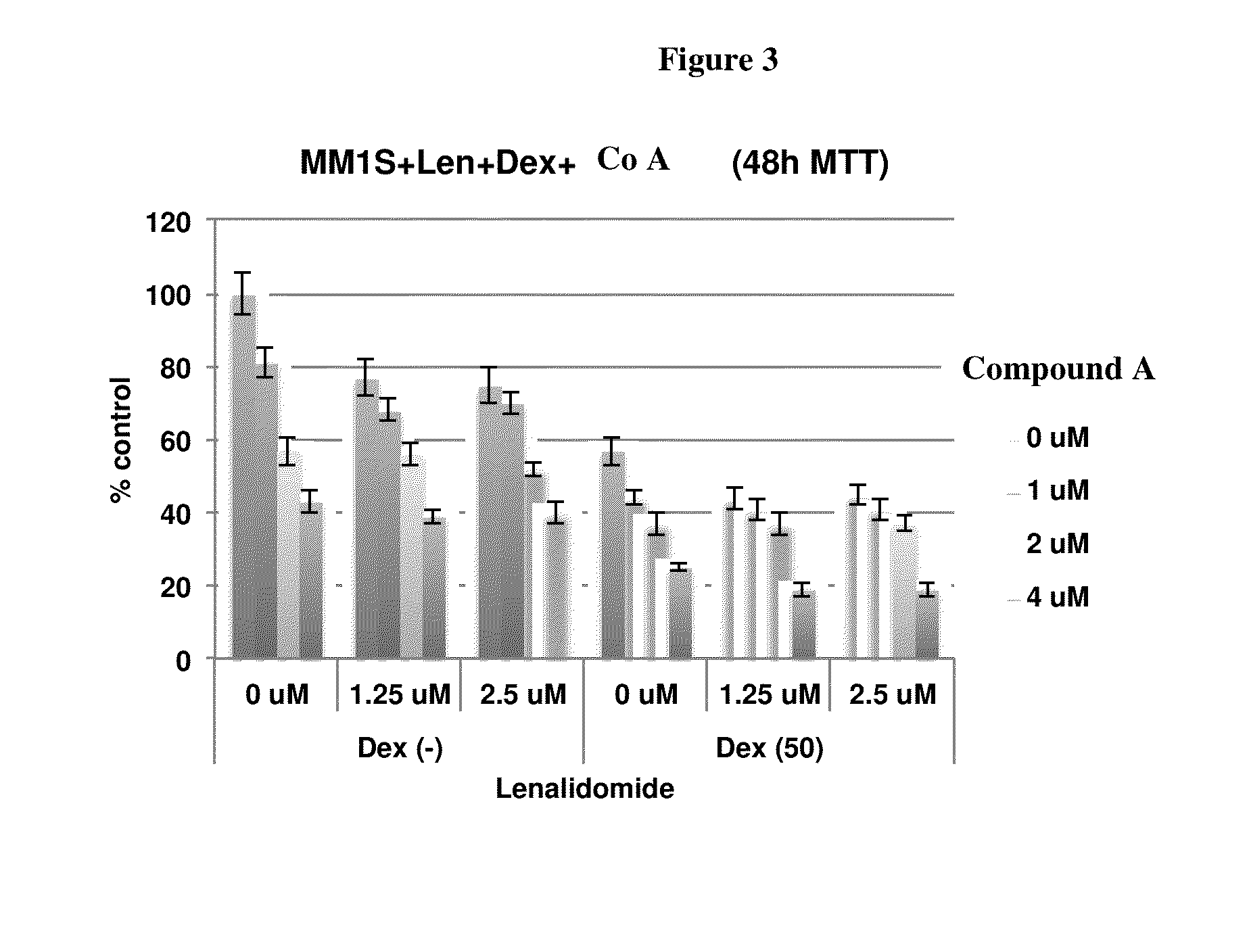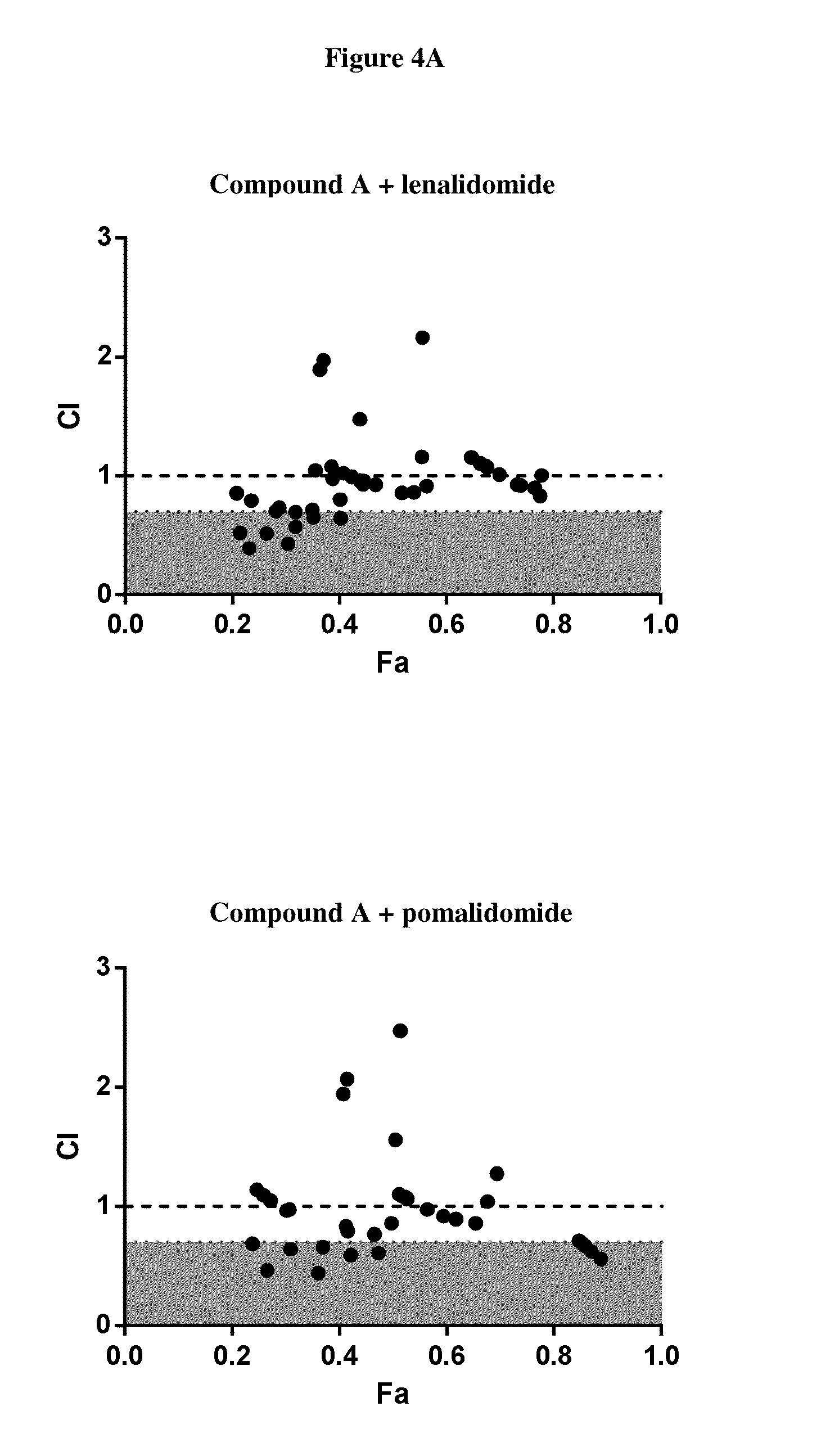Combinations of histone deacetylase inhibitors and immunomodulatory drugs
a technology of histone deacetylase and immunomodulatory drugs, which is applied in the direction of immunological disorders, drug compositions, biocides, etc., can solve the problems of significant limitation of clinical utility and toxicities of patients with dose-limiting toxicities
- Summary
- Abstract
- Description
- Claims
- Application Information
AI Technical Summary
Benefits of technology
Problems solved by technology
Method used
Image
Examples
example 1
Synthesis of 2-(diphenylamino)-N-(7-(hydroxyamino)-7-oxoheptyl) pyrimidine-5-carboxamide (Compound A)
[0387]
Synthesis of Intermediate 2
[0388]
[0389]A mixture of aniline (3.7 g, 40 mmol), ethyl 2-chloropyrimidine-5-carboxylate 1 (7.5 g, 40 mmol), K2CO3 (11 g, 80 mmol) in DMF (100 ml) was degassed and stirred at 120° C. under N2 overnight. The reaction mixture was cooled to rt and diluted with EtOAc (200 ml), then washed with saturated brine (200 ml×3). The organic layer was separated and dried over Na2SO4, evaporated to dryness and purified by silica gel chromatography (petroleum ethers / EtOAc=10 / 1) to give the desired product as a white solid (6.2 g, 64%).
Synthesis of Intermediate 3
[0390]
[0391]A mixture of the compound 2 (6.2 g, 25 mmol), iodobenzene (6.12 g, 30 mmol), CuI (955 mg, 5.0 mmol), Cs2CO3 (16.3 g, 50 mmol) in TEOS (200 ml) was degassed and purged with nitrogen. The resulting mixture was stirred at 140° C. for 14 h. After cooling to rt, the residue was diluted with EtOAc (200...
example 2
Synthesis of 2-((2-chlorophenyl)(phenyl)amino)-N-(7-(hydroxyamino)-7-oxoheptyl)pyrimidine-5-carboxamide (Compound B)
[0398]
Synthesis of Intermediate 2
[0399]See synthesis of intermediate 2 in Example 1.
Synthesis of Intermediate 3
[0400]A mixture of compound 2 (69.2 g, 1 equiv.), 1-chloro-2-iodobenzene (135.7 g, 2 equiv.), Li2CO3 (42.04 g, 2 equiv.), K2CO3 (39.32 g, 1 equiv.), Cu (1 equiv. 45 μm) in DMSO (690 ml) was degassed and purged with nitrogen. The resulting mixture was stirred at 140° C. Work-up of the reaction gave compound 3 at 93% yield.
Synthesis of Intermediate 4
[0401]See synthesis of intermediate 4 in Example 1.
Synthesis of Intermediate 6
[0402]See synthesis of intermediate 6 in Example 1.
Synthesis of 2-((2-chlorophenyl)(phenyl)amino)-N-(7-(hydroxyamino)-7-oxoheptyl)pyrimidine-5-carboxamide (Compound B)
[0403]See synthesis of Compound A in Example 1.
example 3
Synthesis of 2-((1-(3-fluorophenyl)cyclohexyl)amino)-N-hydroxypyrimidine-5-carboxamide (Compound C)
[0404]
Synthesis of 1-(3-fluorophenyl)cyclohexanecarbonitrile
[0405]To a solution of 2-(3-fluorophenyl)acetonitrile (100 g, 0.74 mol) in Dry DMF (1000 ml) was added 1,5-dibromopentane (170 g, 0.74 mol), NaH (65 g, 2.2 eq) was added dropwise at ice bath. After addition, the resulting mixture was vigorously stirred overnight at 50° C. The suspension was quenched by ice water carefully, extracted with ethyl acetate (3*500 ml). The combined organic solution was concentrate to afford the crude which was purified on flash column to give 1-(3-fluorophenyl)cyclohexanecarbonitrile as pale solid (100 g, 67%).
Synthesis of 1-(3-fluorophenyl)cyclohexanecarboxamide
[0406]To a solution of 1-(3-fluorophenyl)cyclohexanecarbonitrile (100 g, 0.49 mol) in PPA (500 ml) was heated at 110° C. for about 5-6 hours. After completed, the resulting mixture was carefully basified with sat.NaHCO3 solution until the PH...
PUM
| Property | Measurement | Unit |
|---|---|---|
| time | aaaaa | aaaaa |
| time | aaaaa | aaaaa |
| time | aaaaa | aaaaa |
Abstract
Description
Claims
Application Information
 Login to View More
Login to View More - R&D
- Intellectual Property
- Life Sciences
- Materials
- Tech Scout
- Unparalleled Data Quality
- Higher Quality Content
- 60% Fewer Hallucinations
Browse by: Latest US Patents, China's latest patents, Technical Efficacy Thesaurus, Application Domain, Technology Topic, Popular Technical Reports.
© 2025 PatSnap. All rights reserved.Legal|Privacy policy|Modern Slavery Act Transparency Statement|Sitemap|About US| Contact US: help@patsnap.com



